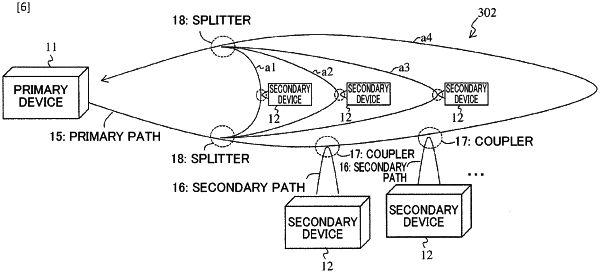| CPC H04L 12/43 (2013.01) [H04B 10/25753 (2013.01); H04L 2012/421 (2013.01)] | 8 Claims |

|
5. A communication method comprising:
transmitting a downlink optical signal to a first end of a primary path, by one primary device;
receiving the downlink optical signal from a second end of the primary path, the primary path forming a primary optical fiber ring;
branching out the downlink optical signal to a plurality of primary sub-paths via a first splitter
transmitting an uplink optical signal corresponding to the downlink optical signal to the primary path by a plurality of secondary devices, some of the plurality of secondary devices being respectively connected to:
the primary path via a plurality of optical couplers and a plurality of secondary paths; and
the plurality of primary sub-paths via the plurality of optical couplers and the plurality of secondary paths, the uplink optical signal from the plurality of primary sub-paths merging into the primary path via a second splitter, wherein the plurality of primary sub-paths have first sub-path ends and second sub-path ends, the first sub-path ends are connected to the first splitter and the second sub-path ends are connected to the second splitter to form a plurality of primary optical fiber sub-rings, and the plurality of primary sub-paths branch out from the primary path via the first and second splitters; and
receiving the uplink optical signal together with the downlink optical signal from the second end of the primary path by the one primary device,
wherein the plurality of primary optical fiber sub-rings share same parts of primary optical fiber ring adjacent to the one primary device for optical signal communications between the one primary device and the plurality of secondary devices connected to the plurality of primary sub-paths, and
wherein, with one cycle being a time including a transmission time for transmitting, as the downlink optical signal, data addressed to each of the plurality of secondary devices and data addressed to every secondary device of the plurality of secondary devices in time division multiplexing, reception time frames for receiving, as the uplink optical signal, data from the plurality of secondary devices, and a guard time arranged between the reception time frames,
the one primary device causes each of the plurality of secondary devices to transmit data in a corresponding reception time frame of the reception time frames allocated thereto.
|